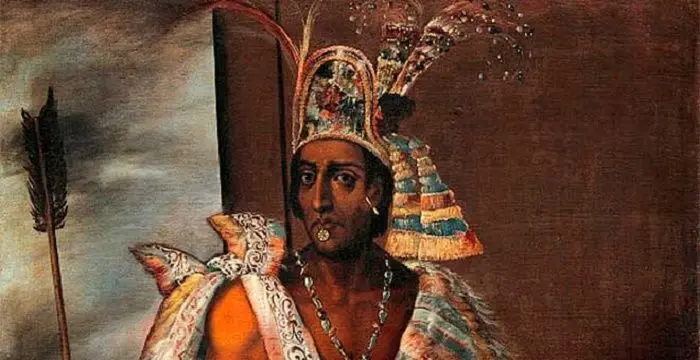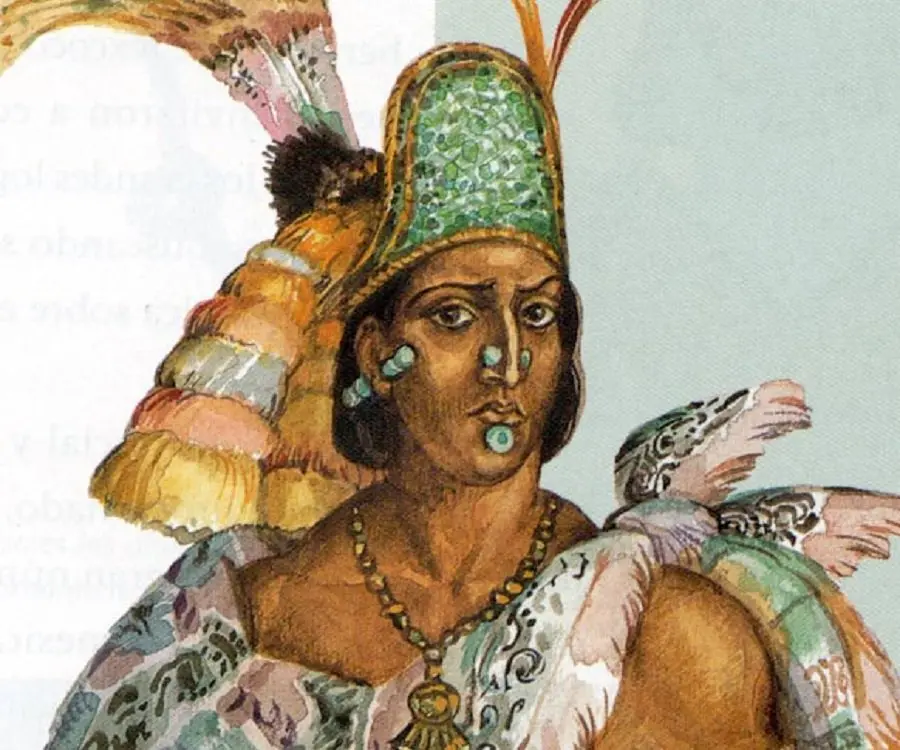
Moctezuma II - Emperors, Timeline and Family
Moctezuma II's Personal Details
Montezuma II was the ninth emperor of the Aztec Empire who ruled from 1502 to 1520
| Information | Detail |
|---|---|
| Birthday | 1466 |
| Died on | June 29, 1520 |
| Nationality | Mexican |
| Famous | Historical Personalities, Emperors & Kings, Emperor of Aztec Empire, Emperors, Kings |
| Siblings | Cuitláhuac |
| Childrens | Chimalpopoca, Isabel Moctezuma, Tlaltecatzin |
| Birth Place | Tenochtitlan |
| Gender | Male |
| Father | Axayacatl |
| Born in | Tenochtitlan |
| Famous as | Emperor of Aztec Empire |
| Died at Age | 54 |
// Famous Kings
Sundiata Keita
Sundiata Keita was the founder of the Mali Empire in West Africa. This biography profiles his childhood, early life, struggles, founding of empire, rule, administration, achievements and also gives some fun facts.
Ashoka
Ashoka was the third emperor of the Mauryan Dynasty and ruled almost the entire Indian subcontinent. This biography profiles his childhood, life, reign, achievements and timeline
Murad IV
Murad IV was one of the mighty Sultans in the history of the Ottoman Empire. This biography profiles his childhood, family, accession, rule, administration and timeline.
Moctezuma II's photo
Who is Moctezuma II?
Montezuma II (also known as Moctezuma, Moteuczoma, Motecuhzoma) was the ninth emperor of the Aztec Empire who ruled from 1502 to 1520. He greatly expanded the Aztec Empire which reached its maximum size during his reign. A brave and ambitious warrior, he undertook several military campaigns which led to the extensive expansion of his empire which grew to include the regions of Xoconosco in Chiapas and the Isthmus of Tehuantepec. He was born as the son of Axayacatl, the sixth Aztec Emperor. He was courageous from a young age and proved himself to be a valiant soldier. His uncle succeeded his father to the throne and Montezuma II played significant roles in the military campaigns launched by the emperors succeeding his father. He ascended to the throne upon the death of his uncle and became the emperor at a time when the Aztec Empire’s glory was at its zenith. He further expanded the empire and introduced several reforms in the administration. Montezuma was also highly superstitious. When Spanish Conquistador Hernán Cortés and his men reached the Aztec Empire, he warmly welcomed them believing them to be messengers of God. The Spaniards made use of the opportunity and made Montezuma II a prisoner in his own palace. The emperor died under mysterious circumstances in subsequent conflicts
Childhood & Early Life
Montezuma was born in 1466 to Axayacatl, the sixth Aztec Emperor, and Xochicueyetl. As was customary for sons of noble birth, he received an education in religion, science, arts, and military training. From a young age he proved himself to be a brave and courageous warrior.
His uncle Tizocic succeeded his father as the emperor in 1481. Tizocic died after a short reign in 1486 and was succeeded by his brother Ahuitzotl who was known to be a great military leader.
Montezuma served as a captain under Emperor Ahuitzotl who launched several military campaigns and aggressively expanded the territories under Aztec dominance. The young price gained important political and military experience under his uncle.
Accession & Reign
Emperor Ahuitzotl died in 1502. At that time Montezuma was serving as an official in Tolocán. A council of noblemen decided that Montezuma should be the next Aztec Emperor and thus he ascended to the throne as Emperor Montezuma II.
He came to power at a time when the Aztec Empire was at the height of its glory. His predecessor had vastly expanded the territories under Aztec rule and Montezuma II had inherited an empire that controlled most of central Mexico and extended to several other regions including present-day southern United States to the middle of Central America.
The Aztec Empire at that time was geographically so vast that it was difficult to control. From the very beginning he had to face and quell rebellions and revolts in his territory. A skilled military leader, he successfully suppressed the rebellions following bloody conflicts which resulted in the death of a large number of villagers.
He became particularly notorious for his cruelty during a rebellion in the provinces of Nopallan and Icpatepec, in 1502. He captured a large number of captives who were ritualistically sacrificed and consumed at his coronation.
Ambitious to further expand the empire he had inherited, he engaged in a series of military campaigns that considerably increased the size of his empire. Between1505 and 1510, he brought the Mixtec and the Zapotec people under his control.
A highly superstitious person, he often ordered the capture of a large number of victims for the religious sacrifices. During the 1510s he became increasingly unpopular because of his atrocities and started facing serious rebellions throughout his territories.
The Aztecs greatly feared their ancestral god Quetzalcoatl, who they believed would return to rule over the empire. Priests and astrologers informed the emperor that Quetzalcoatl could be expected in 1519, instilling in him great anxiety.
Spanish Conquistador Hernán Cortes and his men arrived at the Aztec Empire in 1519 and Montezuma was immediately informed. Because of his superstitious beliefs, he was convinced that the Spaniards were messengers from Quetzalcoatl and sent them expensive gifts.
He then brought Cortes and his men to his palace in the capital city of Tenochtitlán and made arrangements for their comfortable stay. The Spaniards lived as his guests for many months during which Montezuma continued to rule his empire. However, after a period of time, the Spaniards made Montezuma a hostage in his own house. By April 1520, Montezuma II had lost all his powers and respect as the emperor.
Personal Life & Legacy
Montezuma II had numerous wives and concubines. His principal wife was Teotlalco and another one of his major wives was Tlapalizquixochtzin. He is believed to have fathered over a 100 children including dozens of sons.
The extended stay of the Spaniards in the capital city of Tenochtitlán greatly agitated the citizens and several uprisings arose between the native Aztec and the Spaniards. The Spaniards held the emperor hostage and asked him to address the citizens in order to secure their safety. Montezuma II appeared on the balcony of his palace on 1 July 1520 and appealed to his countrymen to retreat.
The Aztecs, angered by the emperor’s complicity and lack of courage, started pelting him with rocks and darts. The emperor reportedly died a few days later. While the Spaniards claimed that he died of the injuries inflicted by his own countrymen, the Aztec stated that he was killed by the Spanish.
// Famous Emperors
Sundiata Keita
Sundiata Keita was the founder of the Mali Empire in West Africa. This biography profiles his childhood, early life, struggles, founding of empire, rule, administration, achievements and also gives some fun facts.
Ashoka
Ashoka was the third emperor of the Mauryan Dynasty and ruled almost the entire Indian subcontinent. This biography profiles his childhood, life, reign, achievements and timeline
Murad IV
Murad IV was one of the mighty Sultans in the history of the Ottoman Empire. This biography profiles his childhood, family, accession, rule, administration and timeline.
Moctezuma II biography timelines
- // 1466Montezuma was born in 1466 to Axayacatl, the sixth Aztec Emperor, and Xochicueyetl. As was customary for sons of noble birth, he received an education in religion, science, arts, and military training. From a young age he proved himself to be a brave and courageous warrior.
- // 1481 To 1486His uncle Tizocic succeeded his father as the emperor in 1481. Tizocic died after a short reign in 1486 and was succeeded by his brother Ahuitzotl who was known to be a great military leader.
- // 1502Emperor Ahuitzotl died in 1502. At that time Montezuma was serving as an official in Tolocán. A council of noblemen decided that Montezuma should be the next Aztec Emperor and thus he ascended to the throne as Emperor Montezuma II.
- // 1502He became particularly notorious for his cruelty during a rebellion in the provinces of Nopallan and Icpatepec, in 1502. He captured a large number of captives who were ritualistically sacrificed and consumed at his coronation.
- // 1505 To 1510Ambitious to further expand the empire he had inherited, he engaged in a series of military campaigns that considerably increased the size of his empire. Between1505 and 1510, he brought the Mixtec and the Zapotec people under his control.
- // 1519The Aztecs greatly feared their ancestral god Quetzalcoatl, who they believed would return to rule over the empire. Priests and astrologers informed the emperor that Quetzalcoatl could be expected in 1519, instilling in him great anxiety.
- // 1519Spanish Conquistador Hernán Cortes and his men arrived at the Aztec Empire in 1519 and Montezuma was immediately informed. Because of his superstitious beliefs, he was convinced that the Spaniards were messengers from Quetzalcoatl and sent them expensive gifts.
- // Apr 1520He then brought Cortes and his men to his palace in the capital city of Tenochtitlán and made arrangements for their comfortable stay. The Spaniards lived as his guests for many months during which Montezuma continued to rule his empire. However, after a period of time, the Spaniards made Montezuma a hostage in his own house. By April 1520, Montezuma II had lost all his powers and respect as the emperor.
- // 1st Jul 1520The extended stay of the Spaniards in the capital city of Tenochtitlán greatly agitated the citizens and several uprisings arose between the native Aztec and the Spaniards. The Spaniards held the emperor hostage and asked him to address the citizens in order to secure their safety. Montezuma II appeared on the balcony of his palace on 1 July 1520 and appealed to his countrymen to retreat.
// Famous Emperors & Kings
Sundiata Keita
Sundiata Keita was the founder of the Mali Empire in West Africa. This biography profiles his childhood, early life, struggles, founding of empire, rule, administration, achievements and also gives some fun facts.
Ashoka
Ashoka was the third emperor of the Mauryan Dynasty and ruled almost the entire Indian subcontinent. This biography profiles his childhood, life, reign, achievements and timeline
Murad IV
Murad IV was one of the mighty Sultans in the history of the Ottoman Empire. This biography profiles his childhood, family, accession, rule, administration and timeline.
Xerxes I
Xerxes I (Xerxes the Great) was the fourth and the most famous king of the Archaemenid dynasty of Persia. This biography profiles his childhood, family, personal life, life history, achievements, campaigns, administration, death and other facts.
Sargon of Akkad
Sargon of Akkad, also called ‘Sargon the Great’, ‘Sarru-Kan’ and ‘Shar-Gani-Sharri’, was the founder and first king of the Akkadian Empire. This biography profiles his childhood, life, rule, administration, timeline, and gives some fun facts.
Abdullah of Saudi Arabia
Abdullah bin Abdulaziz Al Saud was the King of Saudi Arabia from 2005 to 2015 and the third wealthiest head of state in the world. Find more facts about his life, childhood and timeline.
Moctezuma II's FAQ
When was Moctezuma II died?
Moctezuma II was died at 1520-06-29
Where was Moctezuma II died?
Moctezuma II was died in Tenochtitlan
Which age was Moctezuma II died?
Moctezuma II was died at age 54
Where is Moctezuma II's birth place?
Moctezuma II was born in Tenochtitlan
What is Moctezuma II nationalities?
Moctezuma II's nationalities is Mexican
Who is Moctezuma II siblings?
Moctezuma II's siblings is Cuitláhuac
Who is Moctezuma II childrens?
Moctezuma II's childrens is Chimalpopoca, Isabel Moctezuma, Tlaltecatzin
Who is Moctezuma II's father?
Moctezuma II's father is Axayacatl
How famous is Moctezuma II?
Moctezuma II is famouse as Emperor of Aztec Empire






